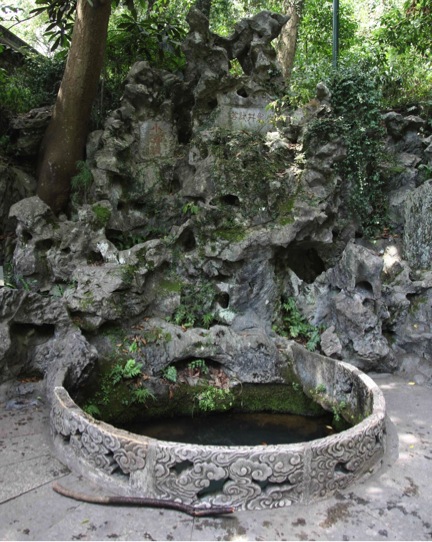Drinking from the Dragon’s Well
 Dragon Well is fed by a clear mountain spring near beautiful West Lake. In ancient times, the spring’s cold, pure waters gathered in a pool known as Longhong that lay sheltered deep within an old forest. Remote and secluded, the pool became the haunt of hermits seeking solitude and tranquility.
Dragon Well is fed by a clear mountain spring near beautiful West Lake. In ancient times, the spring’s cold, pure waters gathered in a pool known as Longhong that lay sheltered deep within an old forest. Remote and secluded, the pool became the haunt of hermits seeking solitude and tranquility.
According to legend, the pool Longhong was silent and placid, but when agitated, the waters emitted a low, mournful sigh, and a mysterious, undulating, liquid coil snaked along the rippling surface and then slowly disappeared. These strange signs marked the watery lair of the benevolent dragon that protected West Lake and the old city of Hangzhou nearby.
Lured by the weird effluence and its resident spirit, wizards and alchemists swirled the wondrous waters from the “well of the dragon” into their elixirs and potions. Tasting sweet and light, the water from Dragon Well lent its name, Longjing, to the green tea grown in the nearby valleys and terraced hills.
Dragon Well tea was but one of many fine teas produced in Hangzhou and admired by tea masters. In his Book of Tea, the eighth century A.D. poet Lu Yü wrote of the tea grown around bountiful West Lake. The slopes of Mount Tianzhu and the Tang temple gardens at the great Lingyin and Tianzhu monasteries produced teas, which though “third in quality,” were considered by Lu Yü still very fine. By the Song period, Dragon Well tea was among over ninety teas worthy of note. Connoisseurs of the Ming dynasty described its qualities: “The taste of Dragon Well is strong and rich, its color like light gold, its essence still and deep. It is long on the palate, and on the tongue, it is fresh and moist and full.”
